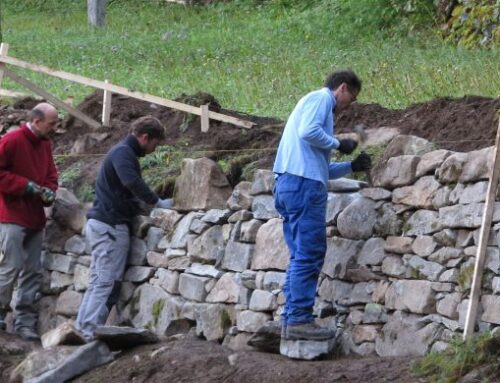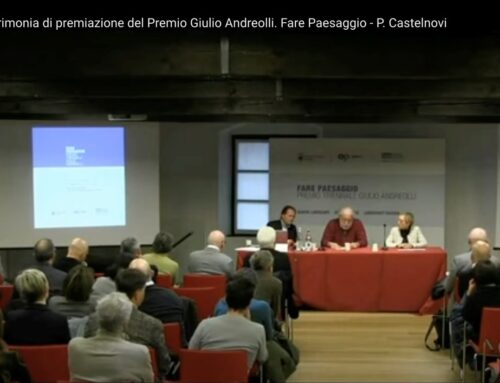It is proposed to territories (from ‘inland areas’ to metropolitan cities) to give space to a strategy of public interest: networking and organising widespread initiatives concerning innovative and experimental ways to improve the quality of life in transport and services for the new needs of the territory.
The opportunity is provided by the prominence given in recent months to SmartCity issues, which up to now have been declined
The opportunity is provided by the prominence given in recent months to the SmartCity themes, which until now have been defined mainly in technological and engineering terms, but, in the declarations, have also been articulated in aspects of social and cultural interest: the Living, People, and Governance axes, which until now have been little more than enunciated, should accompany and provide socio-political support to the Economy, Environment and Mobility aspects.
The substantial European funds, and the albeit considerable Italian funds for research, are mainly concentrated on the Hi-tech aspects of the Smart-city, but nevertheless promote with even significant investments innovation
at the service of the elderly, welfare, schools, participation, inclusion, and cultural heritage management.
Public interest in the strategy rests on two ‘political’ assumptions
– that the crisis imposes the adoption of strong innovations in the governance of cities and services for the quality of life of citizens, and that certainly the innovations best suited to the crisis reduce public spending centres and rely on the widespread, shared and voluntary management of goods and services
– that in Europe the governance of goods and services assigned to organised citizens has been widespread practice for at least two decades, good practices cannot be counted, and the fundamental role of organisational capacity, cross-sectoral integration and the circulation of information between stakeholders emerges.
Therefore, there is a strong characterisation of activity and project applications:
– with participatory management, assigning responsibility for the enhancement of the commons and quality of life to voluntary groups of citizens and enterprises, mostly aggregated in non-profit and non spending third sector associations, with an action supported by the municipality, at a minimum initial cost and 0 when fully operational.
– integrated between environmental and cultural aspects, using available social resources for an accessibility and hospitality offer that improves the quality of life, with budgets in the black (after start-up),
– involving the metropolitan area, implementing a real territorial equalisation between capacity for
investment and consumption capacity of the centres and environmental and housing quality resources of the suburbs.
Below we specify the proposal that
– is based on some innovative considerations to enrich the concept of city and smart (1 and 2);
– proposes as an operational ‘recipe’ a ‘smart’ method of involving subjects and resources (mostly non-monetary) hitherto on the margins of high-tech projects for energy, waste, mobility, outlining the requirements of a web infrastructure for qualified and socially shared sustainability (3);
– traces the references and proposes innovative, smart and low-cost services for an experimental network of aggregating and empowering activities and the connections with strategies for rationalising the res publica and territorial or sectorial policies in progress or planned (4).
-
-
-
- Three attributes of the city suitable for a smart project
a. the city is the productive resource of the new quality, which needs intelligent networks to beput to use. It is possible to consider the city as a resource in a strategic balance both for its assets (the city as a repository of common goods to be utilised) and for the underutilised capacity for investment and energy of its participants (from the ‘intelligent demand supply’ of services for the quality of living, to the quantity of leisure time and monetary resources for its use).If, on the one hand, sustainability criteria and reference values are adopted for urban behaviour (sober in consumption but demanding in the quality of spaces, interpersonal relations, psychophysical health, cultural stimulation), on the other hand, it is also possible to make use of the unpaid investment capacities (in free time, skills and consumption) of citizens and the qualified but underused hospitality and functionality capacities of public assets (of buildings, networks and skills).But the availabilities of each citizen (all to be verified) are in any case not usablelacking an organised framework of potentialities to be applied, i.e:– an inventory, making available and monitoring of resources in terms of their own operational capacities and the (primarily public) spaces and equipment that are under or badly used,
– a series of private associative models, differently targeted but coordinated by a public entity
– a network of relations, direct and web, which makes proposals and good practices evident and links them, and makes critical situations transparent, through constant monitoring
b. the smart city is a vast conurbation, which contains within its territory the primary resources for attempting a certain sustainable environmental balance.
This metropolitan and inter-sectoral dimension also involves from the outset the responsibilities of those who administer the external parts necessary to achieve rebalancing processes.
Therefore, a technical requirement (affecting the territory necessary to support the city) entails a political requirement: an inter-institutional convergence is necessary between the bodies responsible for the territory (the districts, neighbouring municipalities, the province, parks, etc.).
The capital municipality is the ‘natural’ driving force behind the spread of innovation, but it must promote new models in the awareness that the outermost territory of the conurbation is the one that still has reserves of space for integrated innovation of the built environment, for a positive relationship of the city and its citizens with the unbuilt environment, and also for hosting new centralities linked to leisure time.
c. the city coincides with the will of citizens to qualify the sense of living: the smart subject is the active citizen, who organises himself and invests energy for a better long-term quality of living:
willing to take responsibility for strategic programmes
aware of long-term scenarios
interested in social quality and sustainability.
The optimal project is the one that polarises the attention of this type of subject and places them at the centre of the most advanced smart investments, aggregating them in responsible associations, progressively shifting the framework of objectives from rationalising individual consumption to the quality of social living, bringing into play free time (and freed work time) and the themes of public space, common goods, responsibility for zero-cost actions in solidarity, sustainability, hospitality. - Three requirements for smart tools for the participatory city
a. The challenge: to make the city as a responsibly managed and sustainable common good possible. This is an epoch-making goal that is implemented in stages but which from the outset must be seen in its complexity, made up not only of duties but also of pleasures. If in the first phase the smart tools serve the immediate objective of the duty of drastically reducing costs and overall footprints, the methods and utilities that will be developed in this phase are already those that we would also like to use in the phases of greater planning and pleasure. To avoid the technocratic horizon that looms over smart initiatives, we must immediately focus on a synergy that unites the techno part, for the functional efficiency and sustainability of the urban machine, with the cultural and political part, to strengthen the widespread capacity for responsible use of (mostly human) underutilised resourcesb the field of action again on two fronts. For duty: the respectful use of non-renewable resourcesrenewable resources (not only energy but nature and especially time); for pleasure: the enjoyable management of under-utilised resources. Among the under-utilised resources to be explored: first and foremost the ‘designing’ leisure time, the widespread culture of the landscape considered ‘proper’ by everyone, the qualified but neglected places (public or private), the rents of know-how and investments accumulated on an urban scale (production-consumption relations, time and skills spaces for care and culture, good practices of public government and civic entrepreneurs),c. the tool to satisfy the responsible demand for the pleasure of living: a dynamic and progressive integration between the efficiency of immaterial networks and the effectiveness of social and spatial relations of proximity. - Seven experiments to clear the city
Subject Experiment and expected outcomes Models and references Partners and functional relationships A Modern Free Times Association Telematic and logistical organisational services for an association of associations, which is specifically formed to form the infrastructure of delegated management activities of urban places, public spaces and services. The service management sector offices of the local authorities form a framework for the offer and monitoring of available service functions and places, with the relevant conventions, guarantees to be arranged, operating and hospitality requirements to be assigned for management to associations or private individuals. The associations promote management and self-organisation initiatives and encourage the start-up of activities
Associazioni a scala locale: Banche del tempo Più spazio più tempo
Residenze d’artista (puglia, veneto etc)
Più con zero
La scuola adotta un monumento
Circoscrizioni e ass. Politiche sociali dei Comuni
Gestori di luoghi pubblici e servizi (Parchi, scuole, palestre, musei etc.)
integrato con
C (This must be the place),
D (Paysages partagés)
B Association Done Cooked and Eaten Smart organisational and logistical services for an association of associations, to facilitate the direct interaction of – producers (of food and non-food supply chains) interested in the metropolitan hinterland (campagna amica, organic, km.0, farm shopping etc.)
– conscious/ solidarity purchasing groups and centres,
– low cost AND slow food restaurants, or public and company canteens
– producers of commodities for the sustainability of the supply chain (photovoltaics for rural, storage or domestic use, low-consumption transport org., wet disposal etc.):
A sort of Amazon of certified resources for conscious consumption to be facilitated for communication, organisation, monitoring and control, especially in the network formation phase and in the markets, with a portal for
– dedicated purchasing sites and offers (for consumer support for qualified productions and coordination between offer and purchase, also as public procurement)
– self-managed service centres (for transport, storage, accounting, order management, integration with control and certification standards)
Reti GAS (in part. GAS.bio in Toscana),
Gruppi acquisto terreni
GAT
Distretti economia
solidale Brianza, Varese,
Bergamasca.
Arcipelago SCEC
Reti area metropolitana GAS etc. Consumo consapevole
Coldiretti
CIA
Uffici gestione mense comunali e aziendali
Organismi di controllo per monitoraggio e certificazione (Ass.Agricoltura regionale e privati)
integrato con
D (Paysages partagés)
C Association This must be the place Network of smart services for a new generation of tourism, based on in situ knowledge and enjoyment of cultural resources, integrating existing official sites, starting by activating 4 new integrated services (both online and with localised QR codes, findable with smartphones, with maps and with integrated tickets): – completion of the diffuse museum initiatives of the capitals with contributions from other sectors and metropolitan municipalities on places to know and itineraries to integrate them, implemented in a diffuse way (google map model)
– organic contributions on the places of specific city histories (of local political and cultural events) managed and implemented by ‘dedicated’ subjects (order of architects, associations for history and memory, neighbourhoods,….),
– integration of memory maps with film or video clips activated by QRCodes from the places where they were filmed,
– promotion of an association ‘the landscapes of hospitality’ that opens buildings, residences and private estates to organised visits, or events, or even residential internships, contributing to a guide to discover little-known places and activities, to be experienced and not just visited.
Applicazioni QRCode al turismo (Chicago, Montreal, Torino) Musei diffusi e Mappe dei luoghi della memoria
Iniziative Ville aperte (Veneto, Lombardia), Palazzi Rolli Genova
On the set of New York
Associazioni Amici di… per visite guidate
Iniziative Ville aperte e giornate FAI
The London Cultureseekers group
ATL e ass. per turismo Teche RAI e Fondi cinema cittadini
Ass.Commercianti e Centro storico integrato con
A (Tempi liberi moderni)
D (Paysages partagés) per gli spazi aperti
D Association Paysages partagés Services for public-private association in charge of implementing a Green Plan extended to the metropolitan area, concerning – the framework of a ‘Green Bank’ with a territorial equalisation mechanism of transformative interventions for urban, productive or infrastructural uses, in particular all real estate interventions with Smart city facilities, selecting compensatory investments for start-ups of sustainable self-managed ‘Care of Open Landscapes’ projects
– accompanying and monitoring the activities of a ‘Care for Open Landscapes’ project, which are adopted by associations or private individuals (schools, kindergartens, groups for gardens, sports, play or leisure with related services) with agreements that include the obligation of hospitality (public goods) and management (cleaning, security, maintenance), also involving rural operators, accommodation, social assistance for the necessary service activities
Jardins partagés e Jardins Citoyens collectifs in Francia (Lyon, Paris, Grenoble)
Manuali per l’integrazione paesaggistica degli orti urbani e di Agricivismo
Associazione un pugno di terra
Comuni, Provincia, Enti Parco e Regione Associazioni già attive nel settore (società sportive, per orti urbani, convenzioni con agricoltori)
integrato con
A (Ass.Tempi liberi moderni)
B (Ass.Fatto cotto mangiato)
C (This must be the place)
E (Ass Mobile social network) progetti smart di riqualificazione territoriale
E Association Mobile social network Promotion of a project to reduce private motorised traffic and improve the efficiency of public and non-motorised mobility with services for instant sharing by carpooling, facilitating the use by several people of cars going to the same destinations, with the formation of – a dedicated application that can be used by participants in an association that certifies and insures drivers and users, particularly commuters in the hinterland,
– a map of axes and interchange nodes and pick-up points for carpooling,
– an integrated public transport and bike-sharing information system, with dedicated equipment and services and the possibility of reporting inefficiencies and criticalities,
“Real-Time” Ridesharing (USA, Svizzera) Boston bikes
Carpooling
Associazioni Io guido e [TO] bike
Associazione Urbanroller
Comuni, Provincia, Enti Parco e Regione integrato con
C (This must be the place) in
particolare per le ciclabili e progetti smart per mobilità
F Asylum Seeking Association Promotion of a network of schools and nurseries (teachers‘ and parents’ associations) and local centres (districts, smaller municipalities, etc.) that competes to constitute poles for the collection of proposals to be selected for an amplified use of public procurement for the purposes of smart projects of the school and the communities in which the schools are located, with services for
– evidence of rationalisable public budget items, for equipment and services (reduction of waste, rotational or integrated use) and reuse of savings,
– the self-organisation of local and participant resources (carpooling, km0 or self-produced products) for food consumption, transport, care for minors or the elderly)
– good practices for containing consumption and waste disposal, the use of public space and local private networks on smart projects,
– the allocation in management of territorial equipment and minimum skills to develop projects for study, local development and use of free time.
Buying Social Department for Education Fondazione Cresci@mo
Progetto KOM
ntegrato con A (Ass.Tempi liberi moderni)
B (Ass.Fatto cotto mangiato)
C (This must be the place)
D (Ass. Paysages partagés)
G (Rete SmarTorino in action & tour
G Different Houses Association Promotion of a supply network and experimentation of non-standard housing modalities, connected with the emerging demand from solidarity and social integration networks, in order to obtain a housing-park with accommodations including co-housing, common services, collective facilities, to be assigned under direct management etc. or with self-managed management models at zero cost for the public authority
Cohousing Numero Zero Urban Village Bovisa
COSYCOH
OWCH – Older Woman
Cohousing
Cohlonia
ntegrato con tutti i progetti per energia, mobilità, environment e da A a F
- Managing the start-up: establishing primary networks and slow-burning focus points
a On the territory there are already initiatives of local authorities or associations that, autonomously, coordinate small groups for objectives similar to those listed above, often inducing virtuous attempts of management (often private but nevertheless of public interest) of common resources.Unfortunately, the ability to reproduce, to last and to achieve the objectives of these experiences is always drastically limited by their small size, by the lack of coordination on a metropolitan scale and by the lack of inter-institutional and cross-sectoral integration processes in the strategies and governance of the reference bodies. Therefore, the main instrument lacking at this stage is a connecting and coordinating infrastructure, capable of mobilising all energies towards a strategic programme, articulated in many autonomous initiatives, but common and informed.
In instrumental terms, a metropolitan inter-institutional cooperation network is necessary and appropriate. These are the founding initiatives of the Connecting Smart City, which requires an extraordinary political effort for the networks of relationships that must be activated and maintained, but which can be facilitated by an interactive web portal that can also be managed by the comprimary actors (associations, minor entities, universities) and that is coordinated but separate from the current information portals, according to top-down models (regional, provincial, capitals).
b, In any case, a plurality of projects, subjects and bodies should be activated and networked simultaneously.
of projects, subjects and entities at the same time, assuming that overall results cannot be seen immediately.
Hence, in order to give space to expectations, it is necessary to act in successive stages and the general alliance that is felt to be necessary is activated in parts, to be interrelated starting from already existing integration opportunities.
In fact, some initiatives of the aforementioned tenor are already underway, with all the limitations of sectoriality and the scarce commitment of the political context to support them. These efforts and self-organising capacities should be taken as an example (in their extreme diversity) and as a step towards building the overall network. E.g. of the multiformity to be brought into synergy: solidarity networks, ‘you the crisis we the hope’ initiatives, with vegetable gardens etc., coordination of utilities (single ticket with transport etc.), GAS networks,…
c, In addition to collective-initiative experiments and their collection in a virtual site, it is important to mark the first season of Connecting Smart City initiatives with some representative places characterising the new urban landscape. Therefore, it is important to be able to characterise some edge redevelopment or brownfield regeneration sites as real Smart City Factories.
In Smart City Factories, on the basis of an agreement with operators and planners, the entire transformative process of the territory is implemented in a ‘Connecting smart city’ environment, with high participation and communication right from the planning stages, promoting hi-tech and green design solutions but accompanied by careful monitoring of the post-operam phases, costs, user and market reactions.
In the initial phase, it is a matter of concentrating the political, cultural and economic conditions to activate the process in specific sites in the hinterland, choosing them from among those where agreements are already available between organisations and operators for major redevelopment.
operators for important redevelopment or completion work.
These will be initiatives that are currently at a standstill due to the crisis and that can find greater visibility and credibility (also in terms of the funds to be found and the target users) no longer on the quantity but on the quality offered. In other situations, pressure groups have been formed for the implementation of interventions of this kind (finally reversing the NIMBY logic, which is only triggered by the ‘NO signs’…).
Similarly, a Smart City Factory can cover the role of a series of neighbouring initiatives (e.g. in a district), with the common denominator of management and use of public spaces and experimental activities that characterise an urban area for a style that can be systematically found in certain public places (e.g. green spaces and schools, or social housing and the recovery of degraded areas, etc.).
In any case, inter-institutional cooperation is necessary to create the regulatory conditions that favour the experimental performance of Smart City Factories. Therefore, collaboration between technicians, politicians and associations is fundamental, which could find a place of synthesis and interchange in focus points to be hosted in the web portal (point a), to adopt exigent versions of regulations, to reduce bureaucracy, to exigent less performance for the occasional and voluntary use of spaces, with insurance coverage for non-public operators, with the empowerment of users and the verification of minimum safety standards.
- Three attributes of the city suitable for a smart project
-
-




